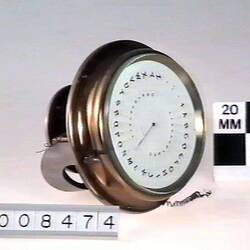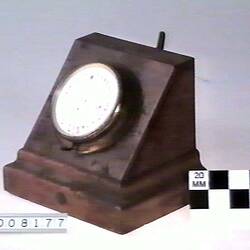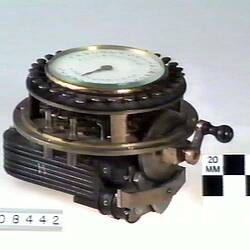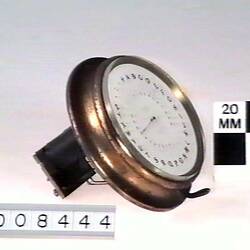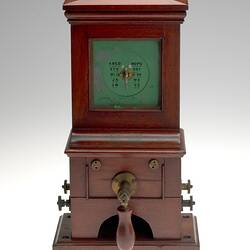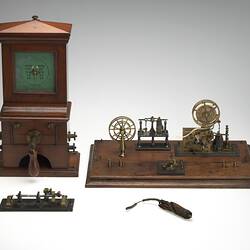Summary
Communicator from a Wheatstone ABC telegraph system.
This communicator is a component of one of the first electric telegraph systems which could be used easily by non-skilled operators. It did not require the operator to learn morse or any other code.
The Wheatstone ABC telegraph system allowed the transmission of telegraph messages without requiring an operator skilled in the use of morse code. The system consisted of a generator, a communicator and an indicator, all mounted on a common base. The communicator had a circular dial with the letters of the alphabet marked around its periphery. Opposite each letter on the communicator dial was a key. The generator was a magneto device which produced a series of current pulses when the operator turned a handle projecting from the base of the unit. The indicator had a circular dial with the letters of the alphabet marked around its periphery and a needlle pivoted at the centre of the dial.
To transmit a letter, the appropriate key on the communicator was depressed and the handle of the generator was turned. A number of pulses corresponding to the selected letter was transmitted over the telegraph wire to the indicator of the receiving station and the needle rotated to indicate the received letter.
The Wheatstone ABC telegraph system was patented in 1858.
Wheatstone ABC telegraphs were used in Victoria in areas where the amount of telegraph traffic did not justify the employment of an operator. They were also used on private lines such as that between the Melbourne 'Argus' newspaper office and the reporters' gallery in Victorian Parliament House.
Physical Description
Circular instrument with a brass case and a white dial. Dial is marked with the letters of the alphabet around its periphery. Inside the ring of letters is ring of numbers. A pointer pivoted in the centre of the dial can move to indicate a particular letter or number. The pointer is mounted on a wire coil which can rotate between the poles of a magnet mounted on the back of the instrument. Outside the periphery of the instrument and opposite each letter is a small circular brass key which can be depressed as required. The instrument is mounted on a hollow wooden rectangular base with the dial horizontal. A crank handle projects from the front of the case, below the instrument. The handle is connected to another moving coil moving between the poles of a set of magnets.
More Information
-
Collection Names
-
Collecting Areas
-
Acquisition Information
Purchase
-
Inventor
-
Inscriptions
The dial is marked above the needle pivot with the words: "C. Wheatstone" and below the needle pivot with the word" "Patent" A small circular metal plate, about 12 mm diameter, on the end of the case, below the communicator handle, is embossed with the number: "3500"
-
Classification
-
Category
-
Discipline
-
Type of item
-
Overall Dimensions
342 mm (Length), 194 mm (Width), 158 mm (Height)
-
References
[Link 1] - accessed 3 December 2008
-
Keywords

